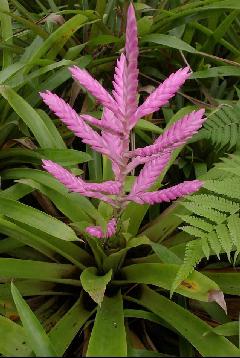
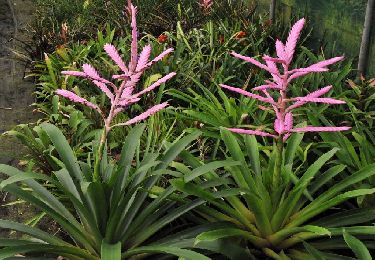
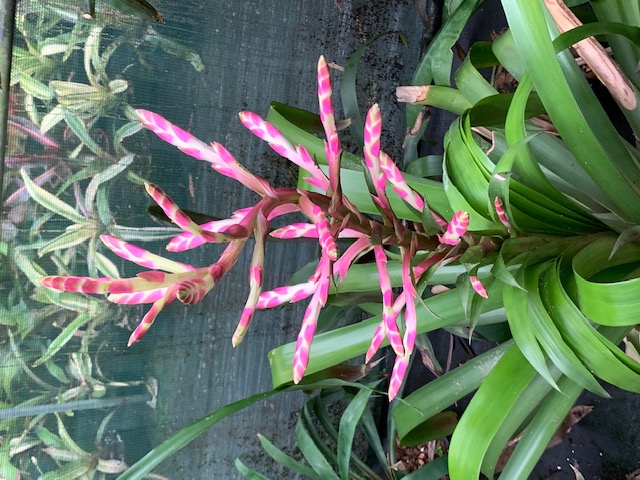
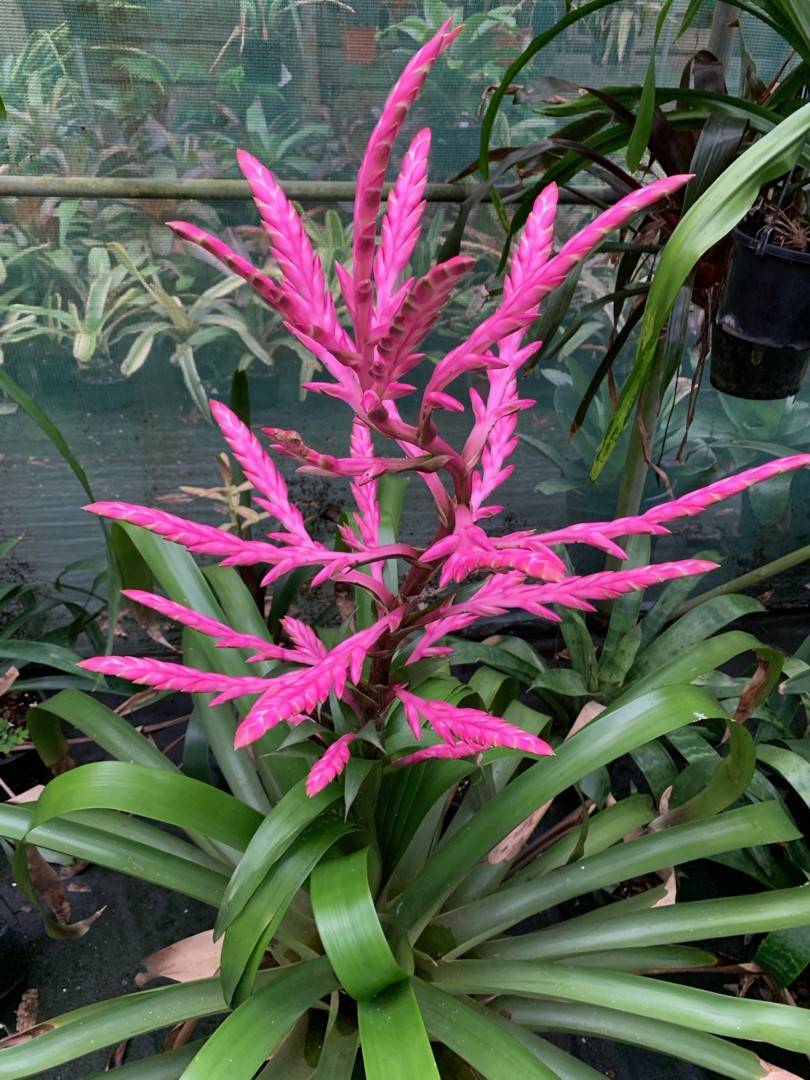
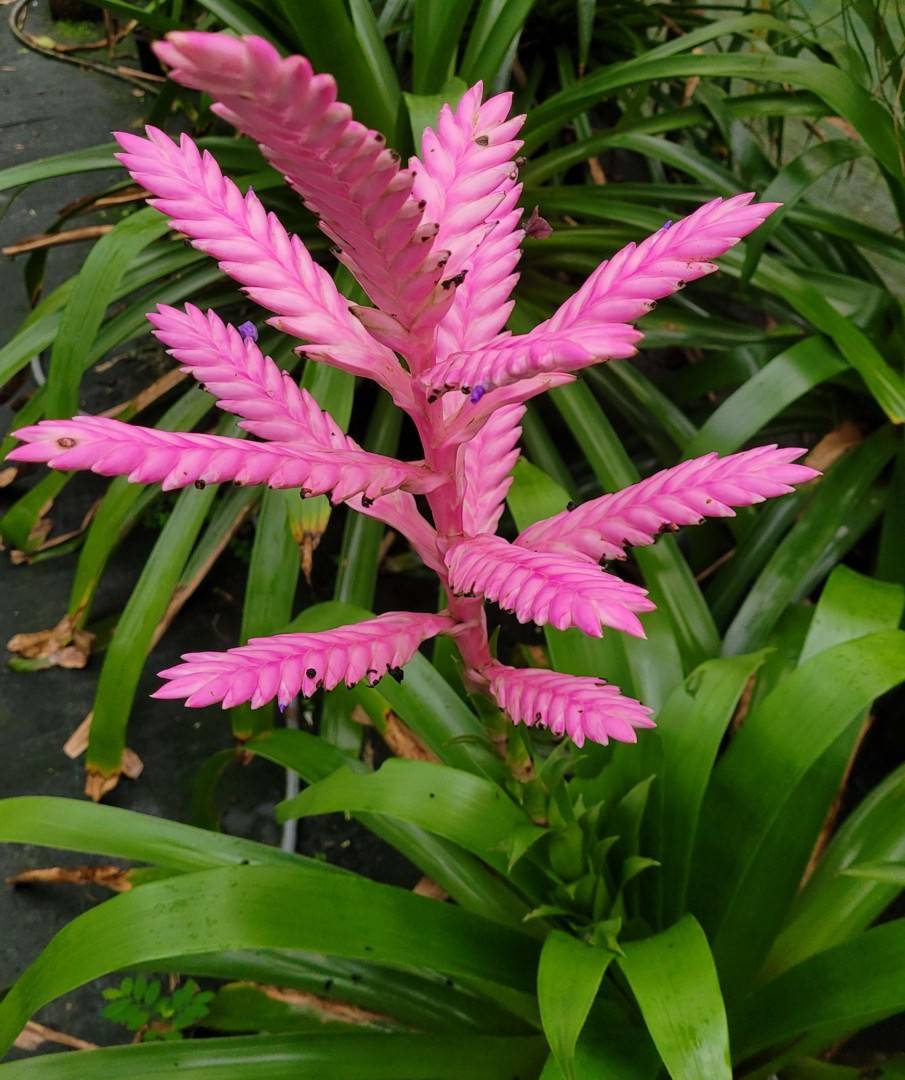
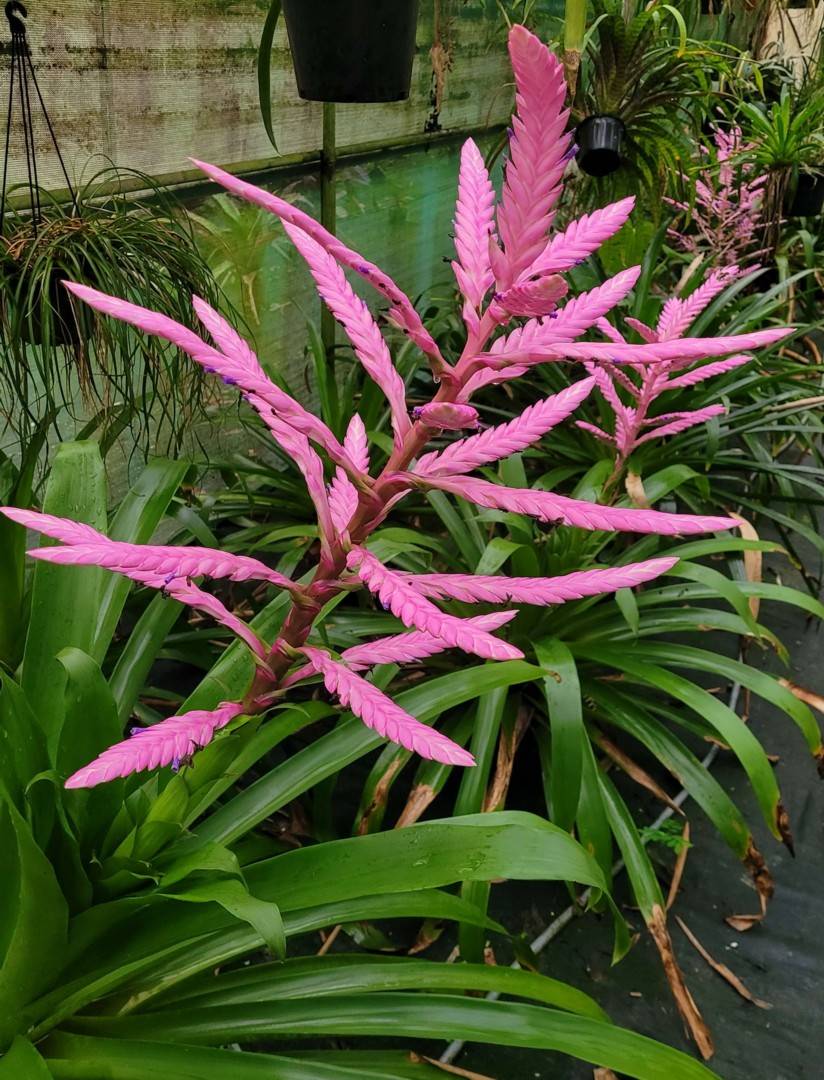
Tillandsia platyrhachis Mez, DC. Monogr. Phan. 9: 848. 1896.
Desc from S&D
Plant stemless, to 6 dm high.
Leaves 6-7 dm long, densely and minutely pale-lepidote beneath, glabrous above;
sheaths ovate, inconspicuous;
blades ligulate, acute, thin, 35 mm wide.
Scape erect, stout; scape-bracts densely imbricate, foliaceous.
Inflorescence bipinnate or with the lowest branches slightly divided, lax, glabrous;
primary bracts triangular, acuminate, exceeding the short naked sterile bases of the branches, lepidote;
spikes oblong, obtuse, 15 cm long;
rhachis geniculate, broadly winged.
Floral bracts suberect to spreading, elliptic, obtuse, 2-3 cm long, much shorter than the sepals, ecarinate, striate, miniate, the margins white on drying;
pedicels obcunic, 5 mm long.
Sepals free, elliptic, obtuse, 2-4 cm long, ecarinate, striate;
petal-blades spreading, suborbicular, 1 cm long, deep violet;
stamens deeply included, exceeding the pistil.
TYPE. Kalbreyer 1328 (holotype K, US photo), without exact locality, Antioquia, Colombia, 1879.
DISTRIBUTION. Terrestrial and epiphytic in rainforest, 1350-1500 m alt, Colombia to central Peru.
ECUADOR. Napo: Rio Pastaza, western Mera, 4 Feb 1934, Schimpf 714 (MO, Z). ZAMORA: km 45, Loja to Zamora, 11 Aug 1965, Gilmartin 1139 (US). PERU. Junin: Schunke Hacienda, San Ramon, Jun 1929, Killip & Smith 24604 (US).
Protologue
Tillandsia platyrhachis Mez, DC. Monogr. Phan. 9: 848. 1896.
212. T. ptatyrhachis; foliis ignotis; inflorescentia tripinnatim panniculata; spicis densiuscule pinnatis, rhachi alis binis de bracteolarum quam sepala optime breviorum dorso decurrentibus valde dilatata floribusque recipiendis excavata; floribus suberectis; sepalis aequaliter liberis; petalis lamina, saturate violacea, suborbiculari, explanata certe 10 mm. lata; staminibus profunde inclusis stylum paullo superantibus.
Planta ex cl. Kalbreyer! bipedalis, diam.rosulae foliorum mihi ignotorum lucide virentium fere metrali. Scapus item ignotus. Inflorescentia eramis erectis, usque ad 0,2 m. longis composita, glabra; spicis breviuscule stipitatis infima basi breviter ramulosis, ad 0,13 mm. longis, 40 mm. latis, apice rotundatis, circuitu late linearibus, glaberrimis, 20-vel permulto ultra floris; rhachi manifeste approximate geniculata; bracteis primariis stricte erectis, triangularibus, longe acutis, flores ramuli axillaris solemniter attingentibus, minutissime peradpresseque lepidotis; bracteis florigeris suberectis, triangulari-ellipticis apice obtusis, miniatis, coriaceis, dorso glabris paulloque prominulo-venosis, ±18 mm. longis. Flores brevissime pedicellati, glabri, per anthesin (petalis explanatis) vix ultra 25 mm. longis; sepalis coriaceis, ± prominulo-venosis, ellipticis, ± 19 nm. longis, 9 mm. latis. Petala sepalis ad 10 mm. longiora laminis suborbicularibus rotundatisque. Stamina antheris ad 5 mm. longis, linearibus, utrinque rotundatis. Ovarium crasse ellipsoideum maximum, stylo percrasso imposito subduplo breviore, antheras medio aequante; stigmate obtuso.
Columbia prov. Antioquia, alt. 1300-1500 m, : Kalbreyer n. 1328, (V. s. in herb. Kew.)
From Gilmartin 1972
7. Tillandsia platyrhachis Mez, 1896 (DC. Monogr. Phaner. vol. 9) p. 848; Smith, 1957, p. 140.
PLANT 50-80 cm tall by ca. 40 cm in diameter;
LEAVES 50-70 cm long, blade 3.5-6.0 cm wide, lingulate, apex acute, subglabrous above, densely appressed lepidote below, sheath ca. 18 cm long by 10-12 cm wide, elliptic, dark brown above when dry;
SCAPE 1.0-1.2 cm in diameter, erect, slightly exceeding leaf-rosette;
SCAPE-BRACTS 3.5-9.0 cm long by ca. 2.5 cm wide, strictly erect, apex acute, completely obscuring scape;
INFLORESCENCE ca. 30 cm long by 20 cm in diameter, bipinnate, lax, glabrous;
PRIMARY BRACTS 3.0-4.0 cm long by 2.0 cm wide, apex acute, erect to spreading, much shorter than spikes;
SPIKES 9.0-14.0 cm long by 4.0-7.5 cm wide, spreading to arching recurved, ca. 7 to 10 per inflorescence, distance between spikes 2.5-4.5 cm, rhachis strongly alate giving webbed appearance between floral bracts, stipe to 2.4 cm long, no sterile bracts, ca. 9 to 19 flowers per spike;
FLORAL BRACTS 2.3-3.0 cm long by 1.3 cm wide, apex acute to obtuse, subcoriaceous, carinate, faintly nerved, glabrous without. slightly lepidote within, erect to spreading, subimbricate at anthesis, strikingly creamy-white when alive, showing up from a good distance, turning dark brown when dry;
SEPALS 2.8-3.1 cm long by ca. 6-7 mm wide, exceeding floral bracts, obtuse, oblong-elliptic, ecarinate, strongly nerved, coriaceous, glabrous without and within, free;
PETALS with blades ca. 1 cm long, deep violet, stamens deeply included within corolla;
OVARY ca. 8 mm long by 3-4 mm in diameter;
CAPSULE ca. 4.0 cm long, seeds light red-brown; distance between flowers 5-8 mm, in flower around April to May.
MATERIAL EXAMINED: Schimpf 714 (Zurich; US, AJG, photo) near Rio Pastaza, Prov. Napo, 1400 m, 4 Feb. 1934; AJG 1139 (US) epiphytic ca. 2 m from ground, tank full of water, not common, rain forest, km 45 Loja-Zamora, Prov. Zamora, ca. 1500 m, 11 Aug. 1965. PERU.
NOTES: This species when alive is very conspicuous for the white appearance of the inflorescence from a distance. The floral bracts are creamy-white when alive.
Tillandsia platyrhachis var. magnifica, Rauh & von Bismarck, JBS 1985 p113 –117, 133-4
Plant stemless, but with a short and thick, rhizomatous base, covered with the remains of the old, dead leaves, flowering up to 2 m (!) high.
Leaves numerous, forming a big, funnelform rosette, up to 1 m high and 2 m in diameter.
Sheaths inconspicuous, lanceolate-ovate, up to 20 cm long and 15 cm wide, densely leatherbrown lepidote on both sides.
Blades ligulate, acute, up to 1.5 m long, 7 cm wide, nearly glabrous on both sides, erect to recurved; the inner rosette-leaves erect.
Scape erect, stout, shorter than the leaves;
Scape bracts densely imbricate, foliaceous.
Inflorescence laxly pyramidal, 1-1.5 m long, 40-50 cm in diameter, tripinnate, only bipinnate in the upper part, with ± 30 suberect to spreading branches.
Rhachis erect, 3 cm thick at the base, round or slightly angled, glabrous, pale pink, its internodes 2-3 cm long.
Primary bracts ligulate, triangular-acute, with a green, lepidote blade and a red sheath, enfolding the rhachis, as long or slightly longer than the sterile bases of the primary branches which are up to 10 cm long. Secondary branches with shorter sterile bases. Spikes horizontally spreading or somewhat curved down, oblong, obtuse, up to 17 cm long and 4 cm wide;
Rhachis geniculate.
Floral bracts divergent to suberect, densely imbricate at their bases, ecarinate, short acute, up to 3 cm long, 1 cm wide, fleshy, glabrous, bright pink, much shorter than the sepals; the base of their dorsal sides deeply excavate and their margins broadly winged. These wings enfolding the apical half of the flower below.
Flowers subsessile.
Sepals 3.5-4 cm long, fleshy, ecarinate, obtuse, free, pale pink, whitish-green at the base. Petals with spreading to recurved, suborbicular, 1.2 X 1.2 cm dark-violet blades, postfloral drying black.
Stamens deeply included, with whitish filaments and yellow anthers Style very short, shorter than the filaments, with big, applanate stigmas.
Ovary oblong, 5 mm high, green.
Fruits up to 5 cm long, greenish, obtuse, angled.
Holotype: Rauh and von Bismarck, No.66107 , 26.10.1984. Known only from the type-locality. HEID
Locality and distribution: Epiphytic in a mist-forest at an altitude of 1900 m, below the Abra Pucara, along the road Tingo Maria-Pucalpa, Dptm. Huanuco, rare.
This plant differs from the type variety platyrhachis in the following characters:
Plant much bigger than 70 cm, but up to 200 cm high;
Leaves not 70 cm long and 3.5 cm wide, but 170 cm long (the sheaths included) and 7 cm wide.
lnflorescence 150 cm long; branches not erect, but spreading up and curving down.
Floral bracts not laxly arranged, but densely imbricate, at least in the basal half, not striate and the margins not white on drying, glabrous, striking bright pink.
Unfortunately, the color of the floral bracts and the sepals is not mentioned in the diagnosis of Mez, although on the label of the type material (Kalkbreyer, 1328, 1879) is written: "bracts pink, very close." Moreover, the type material is very poor and consists of only three spikes. It was collected by Kalkbreyer in 1879 in Antioquia, Colombia, without exact locality being identified and described by Mez. It seems that the T. platyrhachis of Mez has never been re-collected in Colombia, but several times in Ecuador, for example, Schimpf 714, Rio Pastaza, western Mera (Prov. Napo) and A. J. Gilmartin, No. 1139, in southern Ecuador, km 45, Loja to Zamora (Prov. Zamora).
Together with Alexander Hirtz of Quito, I collected T. platyrhachis near the waterfall of the Rio Coca on the way from Baeza to Lago Agrio, in a mountainous forest at an altitude of about 1400 meters (Coll. No.37 571, Sept. 1975). It differs not only from the diagnosis of the type, but also from the Peruvian variety magnifica by the bright creamy-white color of the whole inflorescence A. J. Gilmartin notes also that her specimen of T. platyrhachis is, "when alive, very conspicuous for the white appearance of the inflorescence from a distance. The floral bracts are creamy-white when alive (p. 68)."
Although our plant (No.37 571) is characterized by a bright creamy-white inflorescence, it is not quite certain that the Gilmartin 1139 and Rauh and Hirtz 37571 specimens are identical, because there are other differences stated in Gilmartin's diagnosis (p. 67). Therefore, the following diagnosis is based on our material No.37 571 alone. We think that it is a good variety of the typical T. platyrhachis and name it, owing to the white color of the inflorescence:
T. platyrhachis var. alba (treated as a synonym of T. platyrhachis var platyrhachis in De Rebus I)
Plant stemless, but with a short rhizomatous base.
Leaves numerous, forming a big, erect, funnelform rosette up to 60 cm high and 1.2 m in diameter.
Sheaths up to 18 cm long and 12 cm wide, inconspicuous, dark-brown lepidote above. Blades ligulate, 50-70 cm long, up to 6 cm wide, acute, green, nearly glabrous above and adpressed white lepidote.
Scape erect, up to 3 cm thick (at the base), shorter than the rosette leaves.
Scape bracts densely imbricate, the basal ones subfoliate, the upper ones long-triangular-acute, up to 9 cm long, erect, lepidote beneath.
Inflorescence erect, laxly-pyramidal, tripinnate, up to 70 cm long and 40 cm wide, with numerous, ascending-erect primary branches, the basal ones up to 30 cm long. Inflorescence axis erect, thick, glabrous, white, somewhat angled.
Primary bracts triangular-acute, lepidote beneath, as long or longer than the leafless, basal, flattened, up to 4 cm-long part of the primary branches; basal primary bracts greenish, the upper ones pure white, lepidote beneath.
Secondary bracts loosely distichous, similar to the floral bracts.
Terminal spike of the primary branches up to 20 cm long and 4.5-5 cm wide7 with 20-30 flowers.
Secondary spikes shorter and less rich-flowering.
Spike rhachis flexuous, distance between the flowers in living material 0.3-0.5 cm, in herbarium material 0.7-1 cm.
Floral bracts horizontally spreading, cucculate, acute, 1.5 cm long, 1 cm wide, ecarinate inconspicuously carinate, coriaceous, glabrous, even laxly lepidote within, strikingly creamy-white when alive; the bases of the floral bracts joined with the rhachis and overlapped by the following bracts. All bases of the floral bracts of one spike forming a distinctly engraved zig-zag line running down the middle of the rhachis on both sides. The pouches of the floral bracts are not as deep as in the var. magnifica and are not enfolding the adaxial side of descending order flowers; these with a distinct, divergent, stout, 0.3-0.5-cm long pedicel, which is plainly seen in dried material.
Sepals long-lanceolate, up to 2.3 cm long and 0.7 cm wide, obtuse, coriaceous, even, much longer than the floral bracts, the posterior ones inconspicuously carinate, free, creamy-white, postfloral turning to light green.
Flowers not seen, but probably of the same shape and color as in the var. magnifica. Stamen and style deeply included.
Capsule up to 4 cm long, 3-angled, acute, green.
Holotype: Rauh and Hirtz, ColI. No.37 571 (Sept. 1975), in the herbarium of the Institute of Systematic Botany of the University of Heidelberg (HEID).
Locality: Mountainous forest, near the waterfall of the Rio Coca, 1400 m, Prov. Napo, east-central Ecuador.
The var. alba differs from the type-plant (diagnosis Mez, after material of Kalkbreyer 1328) in the following characters:
Plant much bigger, up to 1.2 m high.
Inflorescence in all parts creamy-white.
Floral bracts smaller; their pouches smaller and the wings not enfolding the adaxial part of the next lower flower.
It is not quite certain if the Ecuadorian plants collected by Schimpf 714 and A. J. Gilmartin 1139 also belong to the var. alba. If so, they are smaller forms.
Some time ago I received from A. Hirtz a color slide of a plant from Peru, labelled T. wagneriana, but comparison shows that it is not T. wagneriana, but a T. platyrhachis which is very close to the type of T. platyrhachis from Colombia.
Following is a provisional key of the T. platyrhachis complex:
1. Floral bracts densely imbricate, at least in their basal half and bright dark-pink; on their dorsal side a deep excavate pouch with broad wings which enfold the adaxial side of the next downwards following flower; these contiguous in their basal parts. Plant up to 2 m high; inflorescence tripinnate => var. magnifica (East central Peru)
- Floral bracts more laxly arranged; rhachis of the spikes visible; plants smaller => 2
2. Floral bracts, inflorescence axis and primary bracts strikingly creamy-white; inflorescence bi- or tripinnate; flowers with 0.5-0.7 cm-long pedicels; pouches of the floral bracts smaller and their wings narrow => var. alba (East central and southern(?) Ecuador)
- Floral bracts and axis probably pale pink; plant only up to 60 cm high; floral bracts more dense than in the var. alba; flowers subsessile => var. platyrhachis (Southern Colombia and Ecuador?)
More collections are necessary to prove this classification.
The Peruvian T. wagneriana L. B. Smith, known only from northern Peru surely is related to T. platyrhachis. Lee Moore collected it first in the vicinity of Iquitos (Prov. Amazonas). Then it was found by Hutchinson and Wright in a mountainous forest on the summit of the Abra Huahuajin near the highway to Montenegro {Prov. Amazonas) at an altitude of 850 meters. We collected T. wagneriana there also, growing together with Guzmania lingulata. Both species, T. platyrhachis and T. wagneriana, belong to the subgenus Phytarrhiza (style short and stout; stamens deeply included and petal blades conspicuous); the floral bracts are of a bright pink (as in the variety magnifica) and the flowers are of a deep blue-violet color. Nevertheless, several important differences exist between both species:
T. wagneriana flowers only 40-60 cm high; the laxly bipinnate inflorescence is up to 20 cm long and has only 5- 7 laxly arranged, horizontally spreading spikes. These are very short (up to 1 cm) stipitated, strongly complanate, linear-lanceolate, up to 12 cm long and 2.5 cm wide and acute. We found only one specimen with obtuse spikes. The rhachis is only narrowly winged by the bases of the floral bracts; these are densely imbricate as in T. platyrhachis var. magnifica, only sublax at the base, strongly carinate, incurved at apex, thin, bright-pink, glabrous and longer than the sepals. The flowers are subsessile, the sepals lanceolate, oblong, acute, 2 cm long, 0.5 cm wide, subfree, the posterior ones carinate, pink and very laxly lepidote inside; petal bases form a narrow, 3 cm-long tube, the deep violet-blue blades are spreading to recurved, broadly elliptic, up to 1 cm long.
The main differences between T. platyrhachis, especially between the var. magnifica and T. wagneriana are the following:
T. wagneriana: Inflorescence bipinnate; spikes short stipitated, horizontally spreading, acute, strongly complanate, floral bracts densely arranged, bright pink, strongly carinate, longer than the sepals; the posterior ones conspicuously carinate.
T. platyrhachis: (the varieties included) Inflorescence bi- to tripinnate; spikes long stipitated, erect to deflexed, not strongly complanate, obtuse; floral bracts bright dark pink or creamy-white, densely (var. magnifica) or laxly (var. platyrhachis), arranged, ecarinate, much shorter than the sepals, the posterior ones inconspicuously carinate.
The differences are so important that, in my opinion, T. wagneriana cannot be considered as variety of T. platyrhachis.